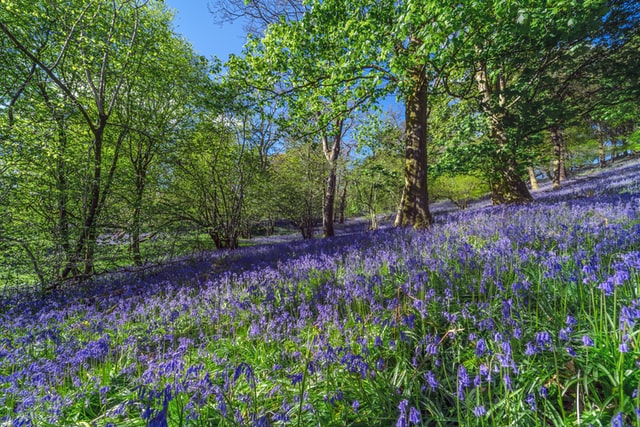Since it was established, Bewl has become a haven for many native animals, birds and fish. Beyond that, the reservoir is surrounded by ancient woodland that is being expertly managed to prevent the growth of invasive species. While we ask you not to pick any of the beautiful wildflowers growing around Bewl, please be welcome to take pictures and look up the different species.
We have three main woodlands around Bewl water, Combewell woods, Pig wood and Frogwell wood. The woods are predominantly ancient semi – natural woodland, with many species that are regularly coppiced and managed. Ancient woodlands are generally defined as woods that have existed naturally since 1600, such woodland now covers only 2.5% of the UK. Many of these woodlands are home to rare wildflowers and elaborate natural ecosystems that have developed over centuries.
Some of the trees in the area are classified as either ancient or veteran trees, there are different classifications for different species as to which are ancient. For example, a Beech many be classified as Ancient at 150 years old where a Yew tree may need to reach 800 to receive the same classification. View some of our veteran trees and where to find them on the woodland trust site.
Trees
For centuries our native woodland has been in decline, but with dedicated efforts to restore and preserve what remains of our ancient woodland the state of our forests has been improving. Efforts to conserve our natural world and native woodland species are ongoing, with dedicated volunteers working to keep our trees flourishing. Here are a few native woodland species that are growing around Bewl water.
Oak
With distinctive round lobed leaves in summer and acorns in autumn, this tree is a quintessentially British species, with oak trees being abundant all over southern England. The tree can live for centuries and is an important food source for animals such as squirrels and birds.
Hornbeam
Hornbeam trees are particularly hardy with leaves similar to a beech, but with a serrated edge. These trees live to over 300 years old, thriving in ancient woodland. The hornbeam’s wood is considered the hardest in Europe and is traditionally used for many purposes where a hardwearing wood is needed. This tree is particularly important to local ecosystems as it keeps its leaves year around, providing a valuable shelter to nesting wild life through the winter months.
Sweet chestnut
Sweet chestnut can live for up to 700 years. This fantastic tree has distinctive green spiked fruits that can be eaten by humans. They are used in a variety of recipes from traditional poultry stuffing, nut roasts and can be traditionally roasted and covered in sugar to be eaten as a dessert. The tree itself is from the same family as oak trees and is similarly hardy.
Horse chestnut differs from sweet chestnut in that it’s fruits are fleshier and the ‘conkers’ are far larger and harder.
Alder
A tree that thrives in wet woodland, alder usually lives for up to 60 years. Due to its preference for mash and wet soil, this tree can thrive in nutrient deficient soil where few other trees would survive. This tree is generally identified by the small brown catkins that remain on the branches year around and their leathery racquet shaped leaves.
The flowers of this tree were said to be used as a dye for outlaws such as Robin Hood and were often referred to as the dye of choice for fairies. The tree bleeds orange sap when cut, giving the impression of actual bleeding, which historically gave the tree a reputation for bringing poor luck.
Hazel
A tree that is often coppiced, these trees have distinctive yellow catkins and hazel nuts. While some edible hazel trees such as cobnuts, are cultivated in the UK (mostly in Kent), most of our hazel nuts are now imported. This tree’s wood is often used for bean poles and pea trellises due to the flexibility of the younger branches.
The tree has long been associated with dormice, that love to snack on the hazel nuts during the autumn. When the leaves are infested by caterpillars in the summer months, the dormice enjoy them as well!
Flowers
Wildflowers are a wonderful sight to see when out for a hike, growing in meadows, woodlands and hedgerows. With the loss of ancient woodland, as well as other habitats around the UK many wildflowers are becoming increasingly rare. However, with dedicated conservation efforts, many are beginning to recover. Many slow growing species such as wood anemone are under particular threat as ancient woodland habitats decrease.
Bluebell
Bluebells are a mainstay of ancient woodland and are often used to confirm the age of a habitat. In many areas bluebells can completely cover the ground creating a spring carpet that is iconic on English woodland.
Wood anemone
One of the first spring flowers this white blossom is found scattered around the woodlands of the south. These flowers are slow growing and spread via rhizomes that spread vertically underground, as such it is reliant on the continuation of its natural habitat and is often used as a good indicator of ancient woodland.
Yellow Archangel
With its appearance similar to a nettle, this flower does not sting but is still part of the nettles family species. Covered in yellow hooded flowers this cheerful bloom lasts until late spring.
Yellow Pimpernel
A creeping plant that is covered in yellow flowers with five petals this distinctive plant loves the shade. Scarlet pimpernel is similar, but is most happy in direct sunlight away from woodland areas.
Wood Speedwell
With leaves with ‘teeth’ and small violet flowers, this seasonal plant is often found in spring. The flowers are similar to a forget me not, but the plant itself stays close to the ground.
Hairy Woodrush
Hairy woodrush is often found in hedgerows and woodland living in shaded areas. A long and tall plant that develops green flower buds, that transform into brown pods often resembling spider’s legs is an interesting flower to see.
Foxglove
Bright pink and deadly, these beautiful flowers are found in gardens, hedgerows and woodland around the UK. This flower can grow to up to 1.5m tall with pink tubular flowers that emerge between June and September. These plants can cause all kinds of problems if ingested, including nausea and headaches, so remember to steer clear!
If you want to know more, have a look at Bewl Water’s management plan from the Woodland Trust to find out how we are protecting and managing our woodland areas.

